|
Aurora Gallery back to spaceweather.com |
| Summary: Solar activity intensified in early November with the appearance of big sunspot 696. The active region unleashed a series of strong M-class solar flares. On Nov. 7th, coronal mass ejections from some of those explosions hit Earth's magnetic field and triggered an extreme geomagnetic storm. [See also the October 2004 aurora gallery.] Page 1 | Page 2 | This is Page 3 | Page 4 | Page 5 | Page 6 | Page 7 | Page 8 | Page 9 Got
pictures? Submit
them. |
| Photographer, Location | Images | Comments | |
|
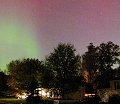
|
Alex Lim,
Chantilly, Virginia, USA Nov. 08 |
#1 |
The sky had a faint reddish glow most of the night but finally around midnight, saw red patch of light and lower near the horizon, a green patch. There was also a large pillar of greenish white light visible. Canon A40, f/2.8, ISO 400, 15 seconds. |
|
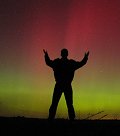
|
Martin Ratcliffe,
Nr Wichita, Kansas. Nov. 07 |
#1 |
Canon G5 digital camera, 10-seconds, 400 ISO at 11:26 p.m. C.S.T. The green auroral arc suddenly lit up with red rays in a symphony of color and activity, fairly fast motion of rays led to an expression of awe caught in this image. |
|
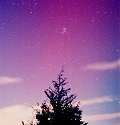
|
John Sachs,
Gettysburg, Pa. Nov. 07 |
#1 |
Very vivid Aurora. Kodak Gold film at 400 ASA. Pentax 35 mm camera with 50 mm lens. |
|

|
Brian Whittaker,
Airborne at 36,0000 feet between London, England and New York, raising to 58 degrees north over the North Atlantic. Nov 7 2100z – 0400z 8 Nov 2004 London to 58N/40W to NewYork Nov. 08 |
#1, more |
An amazing continuous display of Aurora, lasting over 7 hours and 6000 kilometres! While airborne flying between London, England and New York, USA, we were delighted to have an active display literally follow us across the Atlantic Ocean. Always visible, the Aurora ranged from subtle patches of green, to vibrant shimmering curtains of bright red. At times the entire sky was illuminated and dancing all around us. This display uniquely never ended and repeatedly revealed the less commonly observed red hue. The Aurora was also visible from overhead London, and from overhead New York. |
|
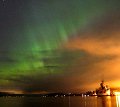
|
Lucas Forschler,
Kirkland, WA, USA Nov. 08 |
#1, more |
This Aurora was shot along the Kirkland waterfront, just around midnight. Canon S400 Digital, 100ASA, 15s exposure |
|
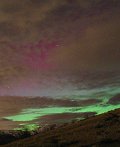
|
Steve Mugleston,
Emigration Canyon, just above Salt Lake City. Nov. 07 |
#1 |
There was quite a bit of cloud cover, but occationally it would part to reveal very bright green and red auroras. We watched the show for over 2 hours. |
|
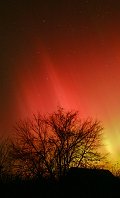
|
Terry Lutz,
Plymouth, Ohio Nov. 07 |
#1, #2, #3, more |
We had a beautiful clear night for the aurora display! I took these with a Canon Digital Rebel, 20mm lens, and 20 sec. exposures |
|
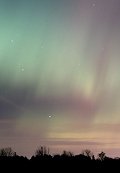
|
Andrew Gillespie,
Elgin IL US Nov. 07 |
#1, #2, #3 |
Amazing!! The third shot is directly overhead. Fuji s-2 iso 400 @30 sec. |
|

|
Christopher Picking,
Wairarapa, North Island New Zealand Nov. 08 |
#1, more |
Animation of Aurora Australis with Southern Cross. Taken with Canon 10D digital camera, 800 ISO, 9x15 second exposures. |
|
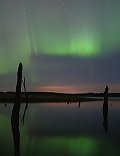
|
Stan Richard,
Jester Park north of Des Moines and suburban Des Moines, Iowa. Nov. 07 |
#1, #2, #3, #4, more |
The most impressive display I've seen yet since I started photographing the lights in June 2000. I used a Canon Digital Rebel, 28mm focal, exposures 10-20 secs at ISO400. Shot RAW. |
|
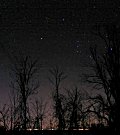
|
Geoff Chester,
Savage Farm, near Snickers Gap in the Blue Ridge mountains, Virginia. Nov. 06 |
#1 |
The eastern skyline as seen from one of the Northern Virginia Astronomy Club's dark-sky viewing sites. Saturn, the Twin Stars of Gemini, and the familiar outline of Orion rise above the dome of 'light pollution' from the Washington, DC metro area and the expanding 'Dulles Corridor'. The site is located about 50 miles west of downtown DC. Image is a photo-stitched panorama of two images made with a Canon PowerShot A70 digital camera set at 15s, f/2.8, ISO 100. |
| more images: from Gilles Boutin of Quebec city, Quebec, Canada; from Rod Kennedy of Casper Wyoming, USA; from Nick Lamendola of Lima, NY; from Jan Curtis of Laramie, WY; |

